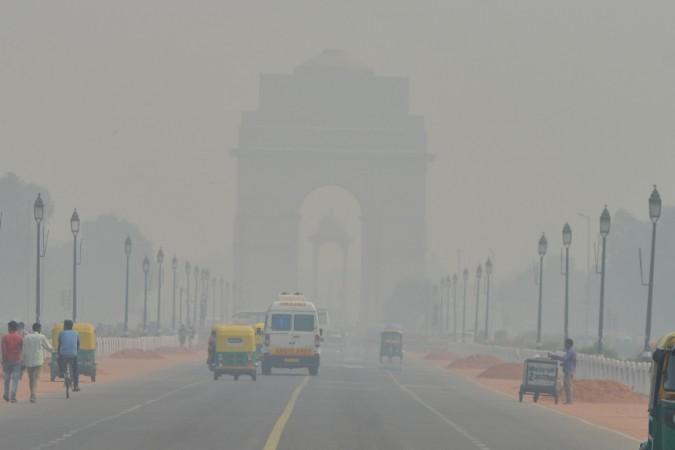
Hours after the Supreme Court-mandated Environment Pollution (Prevention and Control) Authority on Friday declared a public health emergency in the Delhi-NCR region, the state government ordered schools in the national capital to remain closed.
As air pollution levels touched the 'severe plus' category, the top court also banned construction-related works till November 5. Chief Minister Arvind Kejriwal took to Twitter to state that the government has decided to keep all schools in Delhi closed till November 5.
The EPCA also banned the bursting of crackers during the winter season. "We have to take this as a public health emergency as air pollution will have an adverse health impact on all, particularly our children," said EPCA chairperson Bhure Lal in a letter to the chief secretaries of Uttar Pradesh, Haryana and Delhi.
Chief Minister Arvind Kejriwal called the national capital "a gas chamber" as National Capital Region's Ghaziabad was said to be the most polluted zone.
"Delhi has turned into a gas chamber due to smoke from crop burning in neighbouring states. It is very important that we protect ourselves from this toxic air. Through private and government schools, we have started distributing 50 lakh masks today (Friday). I urge all Delhiites to use them whenever needed," Kejriwal tweeted.
PM10 touches the 'severe' category
The PM10 count at 555 slipped to a severe category that was earlier in the "very poor" zone. The PM 2.5 at 383 continues to worsen.
According to Safar India, the calm surface wind condition that has prevailed ever since the Diwali celebrations on October 27, has led to strong surface nocturnal inversion and accumulation of the pollutants.
Even as Delhi's air quality continues to be in the "severe" category - with the AQI on Friday being 533 - the effective stubble fire counts of Haryana and Punjab have shown an increase in trend and reached its peak value this year at 3,178.
Spike in stubble burning
The stubble fire percentage contribution to Delhi's air quality touched the season's highest share of 44 per cent on Thursday and is predicted to be 38 per cent on Friday.
The key government initiative aimed at monetising crop residue to prevent farmers from burning it remains a non-starter. With much fanfare, the previous NDA government in November 2017 announced that it has asked central power utility NTPC to procure farm stubble from states like Punjab and Haryana to be used in its fuel mix.
However, even after two years the necessary infrastructure needed to convert crop residue to pellets for use by the power producer remains almost non-existent. The result is that farm fires continue ahead of rabi sowing season creating foul weather in the Delhi with ambient air quality index remaining in the severe zone, dangerously close to the emergency zone.

Official sources in NTPC told IANS that for the second year running the power producer is unable to find enough suppliers of pellets. Though the company tendered for procuring up to 18,600 tonnes per day of crop residue for generating power last year, it could hardly get any supplies. Even this year, they have just got one supplier who has agreed to supply farm residue pellets of a mere 107 tonnes per day and that also after almost a fortnight's delay.
"We are willing to procure as much pellets as we can get. The company is offering Rs 5,500 for one tonne of pellet, which is a very remunerative price. But suppliers have to come forward," said the source quoted earlier.
As per estimates, crop stubble in 1 acre of land can produce 2 tonnes of pellets. This could fetch farmers Rs 11,000 for stubble from one acre of farmland.
The plan for preventing farmers from burning the stubble involved state-owned Indian Renewable Energy Development Agency (IREDA) financing pellet manufacturing units, which will then bid for NTPC tender. However, executives at the lending agency indicated that they have not received encouraging response from people willing to set up pellet plants.
Government initiative not successful
"As the stubble is generated just for couple of months, no one wants to invest in an infrastructure that would remain idle for rest of the year. Also, farmers find it easy to burn stubble and ready the land for next cultivation than to put additional labour to take it for sale to pellet makers," said an official in the power ministry.
He added that the government may look to further sweeten the deal for pellet makers and farmers to encourage monetisation of stubble rather than its burning. But till that time, the national capital would continue to choke.

NTPC can use 10 per cent of straw pellets in their energy mix. The straw pellets were supposed to be made by start-ups and farming bodies by extracting and crushing the stubble.
In November 2017, the Central Electricity Authority issued an advisory stating that all capable public and private power generating utilities should endeavour to use 5 per cent to 10 per cent biomass pellets primarily made of agro residue along with coal. This is called biomass co-firing.
With the coal-based generation of over 2,00,000 ME in the country, approximately 100 million tonnes of agro residue can be absorbed for producing power with 10 per cent co-firing using non-torrified pellets. However, if pellets of torrified biomass are used, almost all the surplus biomass can be utilised with even less than 10 per cent co-firing.
(With agency inputs)

















